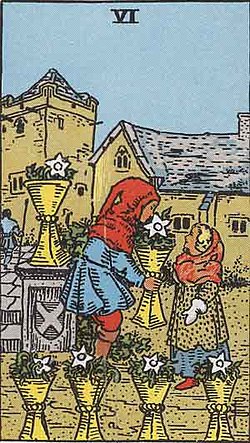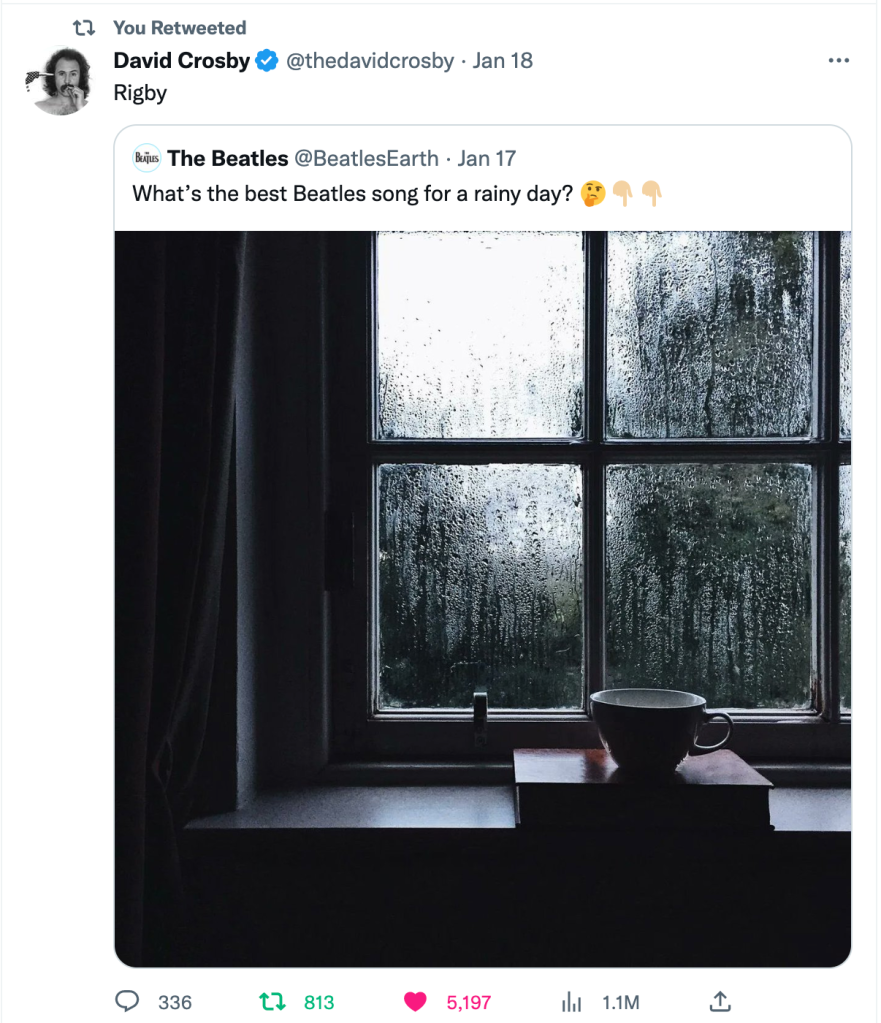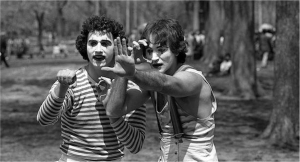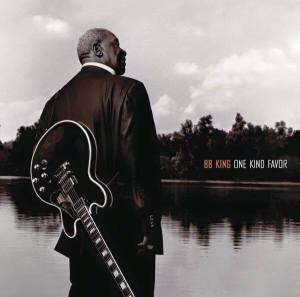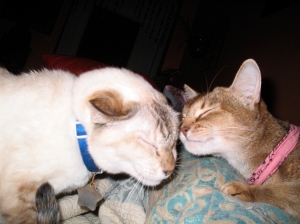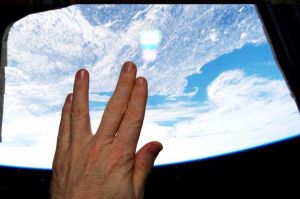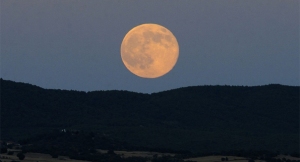Six of Cups
In the tarot deck, the Six of Cups represent a return to our younger days with a focus on happier times and memories. Tarot cards have a range of interpretations, though they work from basic symbols and metaphor. Often, when this card appears in a reading, we may be warned not to become entrenched in the past, though it can be a joyful place to visit. In the card, there are five cups filled with blossoms, with the sixth gently being offered as a gift. It signifies a certain kind of abundance in the world, and represents a vibrant aliveness between the giver and the receiver.
This notion has been resonating with me in my own life, and more recently, with music. Music is heard and felt in time and space. I’m older now, and many of the musicians I loved in my youth are older too, some are passing on. While in the present moment, a song from the past is transporting, evocative…and we visit our past with such vivid, emotional abundance. Longfellow wrote, “Music is the universal language of all mankind.” The universe is a heavenly realm filled with rhythm and harmony, reaching out to the furthest corners of the earth. The musician is the giver, and those of us who listen are bestowed the gift.
One of my little pleasures has been mingling with the creative community on Twitter. This was my last tweet, a retweet, on January 18th. It was from David Crosby. He died the next day. Eleanor Rigby on a rainy day. The Beatles, The Byrds, Crosby, Stills and Nash. The six of cups reminds us to take the gift and its blessing. Linger, but don’t get lost.
David Crosby, eternal bad-ass and brilliant flame, rest in peace.
Can You Feel the Silence?
We search for that breath, and its mindfulness. It’s that deep breath that focuses you on the moment, and fills you with calm and quiet. Too often our lives often become cluttered with the earthly grind of work and worry. We all feel some form of its ache. Some of us find the world is a bumpy road. Some of us find it an easy path to navigate, if not a little dusty now and then.
May you have the good fortune, at least once in a while, to find yourself on a summer’s drive to the countryside. A smooth ride on the open road, where you step out of the mundane, and your old coat, and into the mystic. Finding that deep breath that focuses you on the moment, you are there, in the green of summer, in a place that feels holy, and you feel whole. And you listen to the silence. Can you feel the silence?
Happy Birthday, Van Morrison. Thank you for the ride….
The King of Love
Dr. Martin Luther King Jr. delivered his I’ve Been to the Mountaintop speech on a Wednesday, April 3, 1968. His words were prophetic and resolute:
“…Like anybody, I would like to live – a long life; longevity has its place. But I’m not concerned about that now. I just want to do God’s will. And He’s allowed me to go up to the mountain. And I’ve looked over. And I’ve seen the Promised Land. I may not get there with you. But I want you to know tonight, that we, as a people, will get to the Promised Land. So I’m happy, tonight. I’m not worried about anything. I’m not fearing any man. Mine eyes have seen the glory of the coming of the Lord…”
He was fatally shot a day later. It was Thursday, April 4, 1968.
On Friday, April 5, 1968, Nina Simone’s bass player, Gene Taylor, still in shock and sorrow from the news, composed the song, Why? The King of Love is Dead. Nina Simone’s beautiful rendition was like much of her music, with the deep, low and haunting reaches of her contralto voice echoing a powerful expression of the time. Hers was a voice of the civil rights movement, the healing energy of black pride, of unity, of justice, and of humanity. Here too, we hear the articulation of that path, and its uncertainty, after the loss of the movement’s powerful, peaceful leader, Reverend Dr.Martin Luther King, Jr…as she asks why and what will happen, now that the King of love is dead?
European singer and writer, Lillian Terry, had a jazz radio show in Italy with an impressive roster of jazz artist interviews. In 1968, she added Nina Simone to that list, talking with her poolside at Ms. Simone’s Mount Vernon home in New York. The interview was never heard in the states. Blank on Blank presents the conversation beautifully in animated form. Nina Simone’s words, like her music, are the voice and spirit of the time.
Out of This World

A star so bright, it hurt your eyes to gaze upon it, but you had to look. It was dazzling, mesmerizing…and you never saw anything like it, before or since.
How it pulsed in rhythm and frequency determined where its waves originated, how they traveled, and what the star was made of. These variations set it apart from other stars, revealing the unique sound of the light. This celestial music was as vivid and brilliant as the light. I know. I was there from the start, watching, listening, sprinkled with stardust. It was luminous, amorphous, androgynous, rebellious, mellifluous, marvelous, glorious.
A star so far ahead of its time, was it using up its light faster than it should?
In the star’s evolution, it eventually loses its internal heat source, and becomes a white dwarf. This is its last visible stage — it is still shining because it is still hot. It can feel itself cooling, losing energy. A white star. A thin white duke. A resolute transformation, writing its endpoint, sharing it with you, celebrating it with you. It cools to meet the temperature of the cosmic surroundings, until it can no longer shine, and becomes invisible. Black into the blackness. A black dwarf. A Blackstar.
The brightest star was fearless, flawless, measureless, weightless, Lazarus…
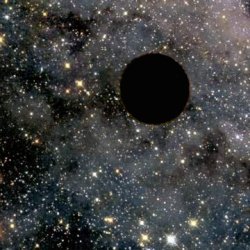
A Soldier In The War On Sadness
He was no ordinary mime. A portal opened from another realm, and he would step through and onto Planet Earth, 40.7789º N, 73.9637º W, before the sweeping steps of the Metropolitan Museum. It was New York City in the 1970s. I was a college student, and my art class met at the museum. Whenever he was there, I was mesmerized by his vibrancy, his intensity, and his silent movement.
Watching him was that moment before lightning hits, when you can sense electricity in the air and feel the back of your neck tingle. He could bend time without uttering a word. Everything would speed up and he’d be manic, weightless, strong. Everything would shift to slow motion. He’d move with grace; centered, solid, fluid. At times, he was as still as stone. Or animated, funny. Earthy, but not earthly, as his ephemeral creations morphed from this to that. You, my friend, like me, would stop and be in the moment.
I saw him enough that I later recognized him on a TV show, without his face paint, but still out of this world. He played an alien. The show: Happy Days. His name: Robin Williams.
You know the rest of the story. He made us laugh long and loud…he was a soldier in the war on sadness. We knew some of his own battles, but did not, until last year, know how brave he was. With so much of his work filled with language and sound, the memory of him, performing in silence, haunts me.
A portal opened from another realm, 37.9128º N, 122.4756º W. It was Paradise Cay, CA, August 11, 2014. Silently, Robin Williams stepped into it, and out of, Planet Earth. You, my friend, like me, stopped to be in the moment. We let his silence fill us.
The Brightness
He was the king, and they said that being Fire over Fire, he could walk through flames and emerge unscathed.
The I Ching’s double fire sign, Li, means “to cling to something,” and “the brightness.” A luminous thing must contain something within itself that perseveres; otherwise it will burn itself out. It must hold fuel to nourish the flame.
Oh yes, Lord, he held on to it. The clinging fused with his being, behind flesh, beyond flesh, illuminating skin to nerve to bone, flowing through his bloodstream like a river of stars. Everything in him was alive with it, grasping it, lit by it. It informed him, defined him. Music was his flame and his fuel.
It was a Twist night gig, where jealousy and anger filled two men and spilled over into the dance hall. Their fight over a woman set the place ablaze. It almost cost the king his guitar, left behind in the mad rush to the door. He went back into the flames for it. When the smoke cleared, the name of the woman who set the night on fire was revealed. A phoenix rising from the ashes, the brightness and the clinging found its name: Lucille.
He knew he was here for this: the blues. A radiant, full hand rocking the string back and forth, bending time with sound. You are here to give witness to the luminosity, to feel its heat, and its truth. From smoky club to concert hall, the spark of his double fire kindled the lamp of every listener. The vibrato shines its light on a path for you. Go this way, brother. Keep it lit.
Dust Particles In A Shaft Of Light
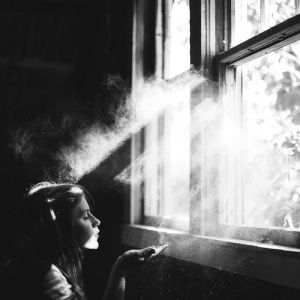
A beam of sunlight filters in through an open window of a room bathed in shadow. The air is still. In the ray of light, dust particles bounce off of one another, illuminated. The fine concentration of light is filled with tiny, radiant specs that are suspended in space, and yet, in motion: floating, shimmering, tumbling together, touching, separating, touching once more.
The physics of it does not matter. The dust-air interaction does not matter. Brownian motion does not matter. Lucretius’ remarkable vision poem of atoms randomly moving in an infinite universe does not matter. Nor does Einstein’s explanation of it. Here’s what matters: You can see it. It is the dust of the world, dazzling in the light.
This is your whole life, right here, right now, contained and elevated, in the ephemeral ray of light pouring in. And you tell yourself: this is the dust of me, the dust around me, what I breathe in, what I breathe out. The dust is filled with thoughts, memories. Mine, yours. Dust from old books. Dust of letters I’ve opened, of papers torn. Dust from my son’s drawings. Dust from cars as their tires leave behind bits of journeys that float through my window, into the beam. Dust of a tissue from my mother’s purse. Dust of my cats, here, and then not here, alive in an eternal way, I suppose, luminous in this narrow beam. Tears evaporate and find their way into the shining zig zag motion. Cherish what you have, and what you have lost. Look for it all, shimmering and tumbling, as dust particles in a shaft of light.

Everything was beautiful and nothing hurt. ~Kurt Vonnegut
RIP, kitty

Touching A Magic Chord
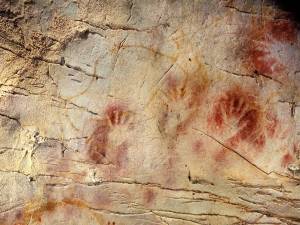
Archaeologists argue the actual date when the first painter stenciled his hand onto cave walls, somewhere in the vicinity of 40,000 years ago. Earliest man was compelled to make a mark, to leave something behind. A memory of him. A gift to us. The human hand is a powerful symbol of our human potential. Flesh and blood, our life coursing through our veins, from our hearts to our hands, and into our sensitive fingers. Touch is how we experience the world.
The hand can reach and grasp: a tool, a paintbrush, a pen, a weapon. Perhaps its greatest strength is what it conveys through gesture, in both the secular and sacred world. Our non verbal communication is a affirmation that something beyond words connects us. The symbolism of a hand gesture may only be within the context of esoteric rite or ritual and known only to that community. Or, it may extend itself to the global family. Our communal symbols and signs are how we experience the world.
From the shameless to the sublime, we know what gestures signify. It is the rudeness of giving someone the proverbial finger. Thumbs up, thumbs down. The calm of the open V peace sign, the power of the fist clenched in solidarity. Deliverance. Defiance. The Hindu and Buddhist mudras. Hands in prayer. The bending of ring finger and pinky in benediction blessing as a sign of the Trinity. A kohen (priest) forming the Hebrew letter “Shin” with both hands, fingers split (“shin” also represents the word Shaddai, a name for God) to confer a blessing.
In an episode of television’s Star Trek called Amok Time, Leonard Nimoy‘s character, Mr. Spock, half human, half alien, is introducing us to other people of his Vulcan race. We are glimpsing an alien greet his alien community. To signify the moment, and to create a richness of their culture and civility, Nimoy created the single hand, split finger version of the kohen’s Hebrew blessing he had seen as a boy. The Vulcan race, with its manner of ritual, of greeting, of community, offers the sign to one another with its message: “Live long and prosper.” It was the power of the hand, the strength of its gesture. Nimoy said that it “touched a magic chord.” It did. We immediately understood.
Leonard Nimoy died on Friday, February 27, 2015. He was 83. He has left his mark, his memory, and his gift to us, in that same unending way as the early man stenciling his hand on a cave wall. To the far reaches of space, where words and time hold no sway, the enduring image remains.
Orbiting 250 miles (400 km) above earth on the International Space Station, NASA astronaut Terry Virts commemorated the passing of Leonard Nimoy with the Vulcan hand gesture. To the right of Virt’s hand is Nimoy’s home state, Massachusetts, though Leonard Nimoy’s world would become so much bigger. We give the greeting to Mr. Nimoy, who gave it to us, this one last time. We offer it in softest silence, as he, now with his fully human heart at rest, makes his voyage to the eternal frontier.
